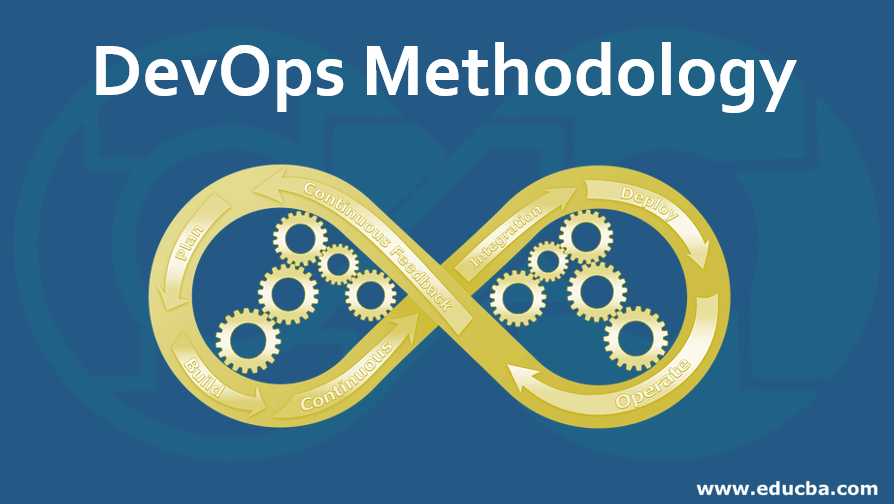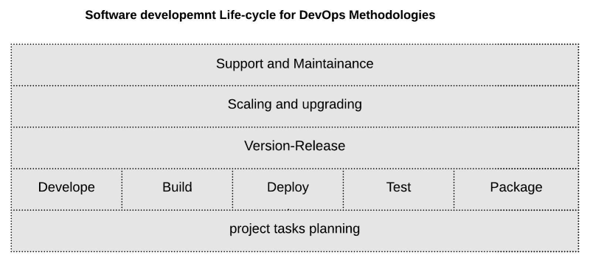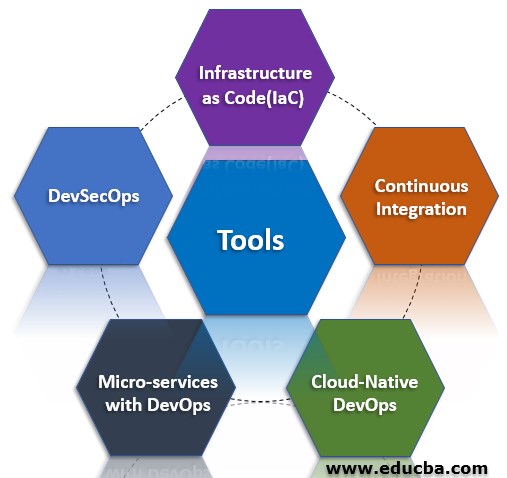Updated May 6, 2023

Introduction to DevOps Methodology
DevOps Methodology is the concept that integrates the task of the development team and operation team for efficient software lifecycle management. DevOps involves several methodologies such as Infrastructure as Code, Continuous Integration and Continuous Deployment (CI/CD), Cloud-Native DevOps, Micro-Services with DevOps, and DevSecOps. It is an evolving field that uses several open-source and enterprise tools. With the growing popularity of cloud and Saas services, the DevOps methodologies are available as managed service by cloud vendor such as AWS, and Azure with some additional features and support. The DevOps Methodology implementation skillset professionals are in high demand in the industry.
DevOps methodology comprises of several practices like:
- Infrastructure as Code
- Continuous Integration Continuous Deployment (CI/CD)
- CloudNative DevOps
- Microservices with DevOps
Stages of DevOps Methodology Lifecycle
Before going into details about each of the methodologies lets us understand the phases or stages involved in a software project lifecycle which DevOps methodologies can help to optimize.
1. Project Tasks Planning: This mainly involves the project management aspects of the software lifecycle. The industry prefers Scrum Sprint or Agile as the preferred practices.
2. Development: This is the major part of the project which involves Source code development and code collaborations.
3. Building the Code: Building the code is part of code compilation or converting the code as the deployable format.
4. Deploy the Code: The deployment in the Test or Sandbox or Production server which is the runtime environment of the project or software.
5. Test the Deployed Resources: Testing is an important phase for Quality assurance of the deployed code in the test servers.
6. Package the Artifacts: There can be a phase involved which will package the production-ready deployable artifacts which can be shared across various channels.
7. Version-Release Cycle: This includes enhancements and a new version release lifecycle.
8. Scaling and Upgrading: This involves performance optimization and infrastructure scaling for load balancing of the deployable artifacts or services.
9. Support and Maintenance of the Services: This involves production support and monitoring, issue escalation, issue fixing, and resolutions for the services or the applications.
Tools of DevOps Methodology
Given below are the tools of DevOps methodology:
1. Infrastructure as Code(IaC)
IaC is a programmatic approach for infrastructure management that enables development practices for the system to automatically scale with the requirements of system provisioning and configurations. Several scripting languages are used to manage IaC.
Some of the commonly used scripting languages are:
- Python Script
- Shell Script
- Windows PowerShell Script
- Batch Script
Apart from the standard scripting languages, there are several tools in the market which manage configuration automation very efficiently.
Some of the commonly used configuration automation or IaC tools are:
- Ansible
- Chef
- Puppet
- AWS Cloud Formation (Templated Infrastructure Provisioning)
2. Continuous Integration Continuous Deployment (CI/CD)
Continuous Integration is a DevOps methodology to integrate the developed source code into the built environment automatically and Continuous Deployment is deploying the generated build files or artifacts to the relevant deployment environment.
1. Some of the common practices involved developing the code using IDE and the IDE is configured with the Code Repository of Version Control system.
Example: Eclipse IDE can be configured to several version control systems using some additional plugins.
2. Storing the code repository on a version controlling system.
Example: Git, Svn repository. Git is the most popular Code repository nowadays which comes with several managed service versions like GitHub, GitLab & BitBucket.
3. For Build Automation there are well know tools that are being used in the industry.
Some of the most commonly used build automation tools are:
Example: Maven, Ant, Gradle
4. Managing build through Scripts and using some Integration pipeline tools like:
Example: Jenkins, Bamboo
The DevOps CI/CD is mainly provisioned to automate the delivery pipeline. There is several components or stages a software project pass-through for an efficient delivery pipeline process. These can vary from organization to organization or application to application as well.
3. Cloud-Native DevOps
In this methodology containers and cloud implementations are part of the Dev Ops which makes Code more portable, reliable, lightweight, and easily deployable.
There are several virtualization tools popular in this context and most of the scenarios these tools are implemented on Cloud.
Some of the most used tools are:
- Docker container
- Kubernetes
- Docker Swarm
- Vagrant
Similarly, the cloud providers providing the hosted managed service as DevOps solution or DevOps as service.
Most popular cloud providers are:
- AWS
- Microsoft Azure
This cloud provides are providing some of the open-source tools as part of their cloud offering services with some additional features.
4. Micro-services with DevOps
- Micro-services is an Integration to DevOps to provide additional capabilities.
- It can be combined with DevOps practices to enable better continuous integration and continuous deployment by accelerating the project lifecycle. Basically, micro-services are modular functionality of a software project or service which is developed and managed independently in an agile way to faster and optimized project delivery.
- By adopting the microservices approach DevOps can be highly useful as the various team involved in the project, no need to wait for each other and the DevOps implementation automate their code sharing and operation collaboration works.
- To support DevOps, we prefer to use Containers and Serverless computing as the technologies for Microservices.
- Example: AWS provides Amazon Elastic Container Service and AWs Lambda as part of DevOps Microservices offering.
5. DevSecOps
DevSecOps is an Integration to DevOps to provide additional capabilities. DevSecOps methodology is the security provisioning process that enables various security features for each phase or method of DevOps. Due to the rapid implementation of new technologies and monitoring tools security concerns in DevOps is a major roadblock in some of the organizations which is mostly related to governance or compliance.
Security factor (sec) sits on top of any other DevOps methodology considering security as a priority in the DevOps implementation plan. This implementation is comparatively complex for general DevOps. It’s more about the mindset and understanding of the implementation team to adhere to the new set of security practices for adding new security-based tools to the DevOps to technology stack.
We can use basic security implementations as DevSecOps.
- Vulnerability scan
- Identity access management
- Firewalls
- Security policies configuration
- Proper authentications mechanisms while adding DevOps tools
Conclusion
The IT industry is continuously evolving, and DevOps is a concept that is growing in popularity as more technologies and concepts are being added. It creates a disruption in the traditional system administration, software development, and product delivery job roles. Indeed the major IT workforce is aware and skilling up with DevOps.
Recommended Articles
We hope that this EDUCBA information on “DevOps Methodology” was beneficial to you. You can view EDUCBA’s recommended articles for more information.


